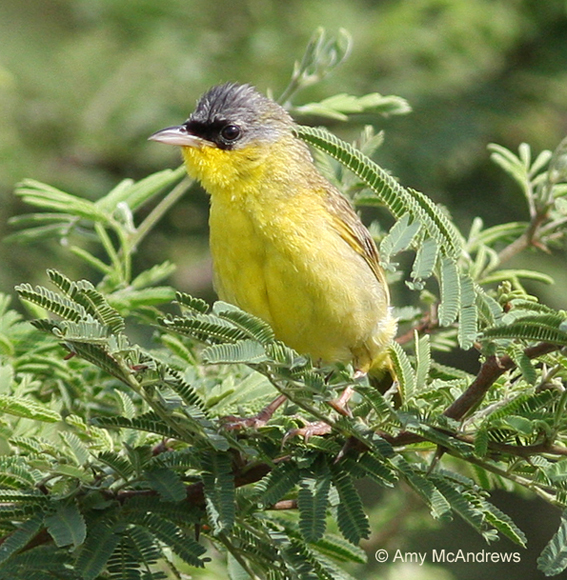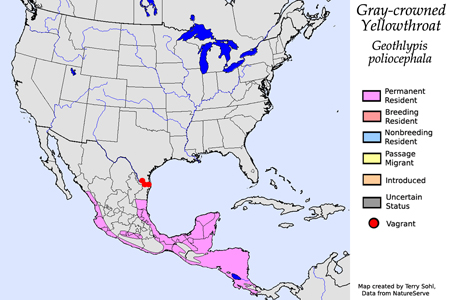| Length: 5.5 inches | Wingspan: 8.5 inches | Seasonality: Non-resident in South Dakota |
| ID Keys: Gray crown, black or blackish lores; relatively stout, pale bill; yellow underparts; olive-brown upperparts | ||
 The
Gray-crowned Yellowthroat is normally found from northern Mexico southward
through Panama. In the United States they are a vagrant, albeit with a
number of sightings in far southern Texas near the Rio Grande river valley.
The species was recorded as nesting in the United States in the late 1800s,
and was even considered a relatively common breeder in a few counties along
the Rio Grande. However, by 1920s they had seemingly disappeared.
While occasional sightings occurred after that, it wasn't until 2005 that
nesting in the U.S. was again confirmed, when a nest was found in Cameron
County, Texas. Given the proximity to known nesting locations in
northeastern Mexico, continued sightings in far southern Texas, and the
potential impacts of a warming climate on the species' distribution, further
breeding within the U.S. is considered likely.
The
Gray-crowned Yellowthroat is normally found from northern Mexico southward
through Panama. In the United States they are a vagrant, albeit with a
number of sightings in far southern Texas near the Rio Grande river valley.
The species was recorded as nesting in the United States in the late 1800s,
and was even considered a relatively common breeder in a few counties along
the Rio Grande. However, by 1920s they had seemingly disappeared.
While occasional sightings occurred after that, it wasn't until 2005 that
nesting in the U.S. was again confirmed, when a nest was found in Cameron
County, Texas. Given the proximity to known nesting locations in
northeastern Mexico, continued sightings in far southern Texas, and the
potential impacts of a warming climate on the species' distribution, further
breeding within the U.S. is considered likely.
Habitat: Found in shrubby, open habitats. This may include tall grasses with scattered shrubs, brushy thickets, young second-growth in forest clear-cuts, and brushy forest clearings.
Diet: Feeds mostly on insects and spiders. They will also sometimes feed on seeds or berries.
Behavior: Most foraging occurs while clambering and flitting through thick brush and thickets. Insects and spiders are gleaned directly from vegetation, although sometimes they will make short flights to capture flying insects in mid-air.
Nesting: The nest is a small cup built of grasses and leaves, usually placed in a thick clump of tall grass. The female usually lays between 2 and 4 eggs, and she alone incubates them. The eggs typically hatch after 10 to 12 days.
Song: The most commonly heard vocalization is a somewhat low-pitched chee-dle chee-dle chee-dle
Migration: Considered a permanent resident throughout their normal range.
Interactive eBird map: Click here to access an interactive eBird map of Gray-crowned Yellowthroat sightings
Similar Species: Similar overall to Common Yellowthroat. The amount of black on the face of a Gray-crowned Yellowthroat varies across their range, but the black is typically limited to the lores and upper bill area, and is far less extensive than that on a Common Yellowthroat.
Conservation Status: Populations of Gray-crowned Yellowthroat are large, cover a broad geographic area, and overall are considered stable. The IUCN lists the Gray-crowned Yellowthroat as a species of "Least Concern".
Further Information: 1) BirdLife International - Gray-crowned Yellowthroat
2) Cornell's NeoTropical Birds - Gray-crowned Yellowthroat
3) WhatBird - Gray-crowned Yellowthroat
Photo Information: Photo by Amy McAndrews - August 22nd, 2008, Tehuantepec, Oaxaca, Mexico - Photo licensed under Creative Commons Attribution NonCommercial NoDerivs 2.0 Generic License
| Click below for a higher-resolution map |
 |
| South Dakota Status: Non-resident in South Dakota |
Additional Gray-crowned Yellowthroat Photos (coming soon!!)
